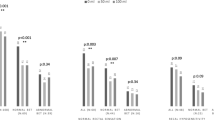Abstract
Purpose
The effects of rapid sustained inflation versus rapid inflation/deflation of the intrarectal balloon upon rectoanal inhibitory reflex (RAIR) parameters were evaluated in asymptomatic subjects.
Methods
Forty asymptomatic adults were submitted to anorectal manometry with rapid or sustained inflation with 30 and 60 mL air. The average age was 27.4 years (range, 20–40). The subjects were divided into Group I (20 men) and Group II (20 women) for analysis. RAIR parameters were registered in order to compare the inflation patterns within each group, and Groups I and II were compared for each inflation pattern with regard to RAIR parameters.
Results
Sustained inflation significantly increased IAS relaxation time and duration of the reflex in both groups, and IAS tone recovery time in Group I.
Conclusions
RAIR parameters are influenced by the choice of inflation pattern. Further studies are required to establish a standard intrarectal balloon inflation pattern.
Similar content being viewed by others
References
Jorge JMN, Wexner SD (1993) Anorectal manometry: techniques and clinical applications. South Med J 85:8:924–931
Góes JRN, Simons, Masi L, Beart RW Jr (1995) Gradient of pressure and time between proximal anal canal and high-pressure zone during internal anal sphincter relaxation: its role in the fecal continence mechanism. Dis Colon Rectum 38:1043–1046
Freys SM, Fuchs KH, Fein M, Heimbucher J, Sailer M, Thiede A (1998) Inter-and intraindividual reproducibility of anorectal manometry. Langenbecks Arch Surg 383:325–329
Zabar AP, Aslam M, Gold DM, Gatzen C, Golsing A, Kmiot WA (1998) Parameters of the rectoanal inhibitory reflex in patients with fecal incontinence and chronic constipation. Dis Colon Rectum 41:2:200–208
Kaur G, Gardiner A, Duthie GS (2002) Rectoanal reflex parameters in incontinence and constipation. Dis Colon Rectum 45:928–933
Marzio L, Lanfranchi GA, Bazzocchi G, Cuccurullo F (1985) Anorectal motility and rectal sensitivity in chronic idiopathic constipation: effect of high-fiber diet. J Clin Gastroenterol 7:391–399
Rao SS, Hatfiedl R, Soifer E (1999) Manometric tests of anorectal function in healthy adults. Gastroenterology 94:773–783
Eckardt VF, Elmer T (1991) Reliability of anal pressure measurements. Dis Colon Rectum 34:72–77
Corman ML, Allison SI, Kuehne JP (2002) Anatomy and embryology. In: Handbook of colon & rectal surgery. Lippincott Williams & Wilkins, Philadelphia, pp 1–13
Ortolani D, Bonomo S, Bottura D, Castellini C, Zugni C, Lolli P (2005) La manometria anorettale: standardizzaione della tecnica di esecuzione. Chir Ital 57:199–205
Sun WM, Read NW, Prior A, Daly J, Cheah SK, Grundy D (1990) Sensory and motor response to rectal distention vary according to rate and pattern of balloon inflation. Gastroenterology 99:1008–1015
Thompson WG, Longstreth GF, Drossman DA, Heaton KW, Irvine EJ, Muller-Lisner AS (1999) Functional bowel disorders and functional abdominal pain. Gut 45:1143–1147
Rosa G, Lolli P, Piccinelli D, Mazolla F, Zugni C, Ballarin A, Bonomo S (2005) Calibrated lateral internal sphincterotomy for chronic anal fissure. Tech Coloproctol 9:127–131
Rosa G, Lolli P, Piccinelli D, Mazolla F, Bonomo S (2006) Fistula in ano: anatomoclinical aspects, surgical therapy and results in 844 patients. Tech Coloproctol 10:215–221
Soifer LO, Olmos A, Caruso P (1990) Evaluacion del compromisso del esfincter anal interno mediante la medicion de la intensidad del reflejo ano-rectal inhibitorio. Acta Gastroenterol Latinoamer 20:221–224
Farouk R, Duthie GS, Pryde A, Bartolo DC (1994) Abnormal transient internal sphincter relaxation in idiopathic pruritus ani: physiological evidence from ambulatory monitoring. Br J Surg 81:603–606
Netinho JG (2002) Intensidade e duração da recuperação do relaxamento esfincteriano induzido pelo reflexo inibitório reto anal e sua correlação com a constipação por evacuação obstruída. Thesis, University of Campinas, São Paulo Brazil
Kalantar JS, Howell S, Talley NJ (2002) Prevalence of faecal incontinence and associated risk factors. An underdiagnosed problem in the Australian community? MJA 176:54–57
Blumberg H, Haupt P, Janig W, Kohler W (1983) Encoding of visceral noxious stimuli in the discharge patterns of visceral afferent fibres from the colon. Pflugers Arch 398:33–40
Sabate JM, Coffin B, Jian R, Le Bars D, Bouhassira D (2000) Rectal sensitivity assessed by a reflexologic technique: further evidence for two types of mechanoreceptors. Am J Physiol Gastrointest Liver Physiol 279:692–699
Diamant ND, Kamm MA, Wald A, Whitehead WE (1999) AGA technical review on anorectal testing techniques. Gastroenterology 116:735–760
Williamson ME, Lewis WG, Finan PJ, Miller AS, Holdsworth PJ, Johnston D (1995) Recovery of physiologic and clinical function after low anterior resection of the rectum for carcinoma: myth or reality? Dis Colon Rectum 38:411–418
Azpiroz F, Enck P, Whitehead E (2002) Anorectal functional testing: review of collective experience. Am J Gastroenterol 97:232–240
Rociu E, Stoker J, Eijkemans MJ, Laméris JS (2000) Normal anal sphincter anatomy and age-and sex-related variations at high-spatial-resolution endoanal MR imaging. Radiology 217:395–401
Regadas SMM, Regadas FSP, Rodrigues LV, Silva FR, Lima DMR, Regadas-Filho FSPR (2005) Importância do ultra-som tridimensional na avaliação anorretal. Arq Gastroenterol 42:226–232
Jorge JMN, Habr-Gama A (2000) The value of sphincter asymmetry index in anal incontinence. Int J Colorectal Dis 15:303–310
Author information
Authors and Affiliations
Corresponding author
Rights and permissions
About this article
Cite this article
Monteiro, F.J.R., Regadas, F.S.P., Murad-Regadas, S.M. et al. Comparative evaluation of the effect of sustained inflation and rapid inflation/deflation of the intrarectal balloon upon rectoanal inhibitory reflex parameters in asymptomatic subjects. Tech Coloproctol 11, 323–326 (2007). https://doi.org/10.1007/s10151-007-0374-6
Received:
Accepted:
Published:
Issue Date:
DOI: https://doi.org/10.1007/s10151-007-0374-6




